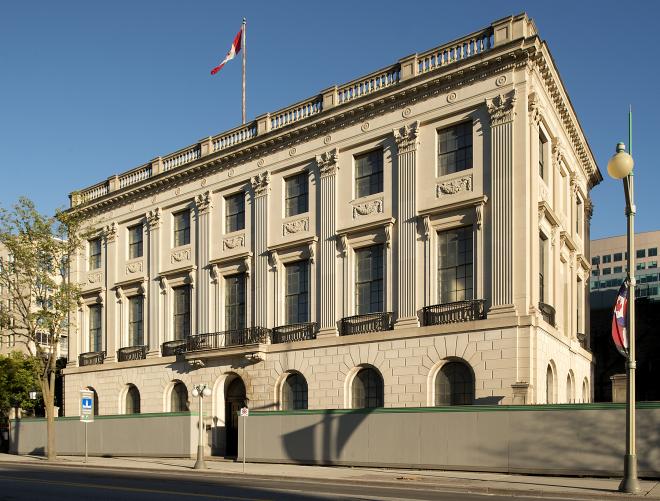By Peter Coffman, Carleton University
First the good news: the federal government is serious about establishing an indigenous cultural centre in the nation’s capital. This is badly needed and long overdue. As well as (one hopes) inching us a bit further down the road to reconciliation, it will immeasurably enrich the national narratives that the capital weaves.
Now the bad news: the government plans to house this centre in the former American Embassy at 100 Wellington. I blogged last fall about why I thought this a bad idea, but as the issue has floated back to the top of the news cycle, it’s worth reiterating and expanding on those thoughts.
Buildings have meaning. They speak, they express world-views, they proclaim values and tell stories. Our Parliament Buildings used the most progressive Victorian Gothic Revival style to speak of our place at the cutting edge of a venerable history. The current US Embassy is a sleek modernist fortress that speaks of power and authority. Important public buildings have such messages built into them.
So what does the former US embassy on Wellington Street have to say?
Undoubtedly it is a beautiful building in a symbolically important location right across the street from Centre Block. I imagine that, to some, its quality and site are viewed as a tribute to the importance of an indigenous centre. But let’s look more closely at what this building is, and what kind of historical story it tells. Its Classical style originated in ancient Rome, and spread across what is now Europe, Asia and Africa as a symbol of Roman imperial might at the peak of their empire 2000 years ago. This particular building is filtered through the lens of the Italian Renaissance, and specifically the luxurious palazzi (palaces) built by architects like Palladio and Alberti for their one-percenter patrons in places like Vicenza and Florence. And of course the building was originally made to serve as the embassy of the United States of America, a nation with its own deeply entrenched ideas of imperial destiny.
In short, the architectural style of 100 Wellington has been honed over two millennia to express and embody Western cultural power and dominance. Hands up everyone who thinks that’s the perfect place for a centre celebrating indigenous culture?
To shoehorn an indigenous cultural centre into a building that oozes Western authority and triumphalism from every stone is not just ironic, it’s unconscionable. What it says to indigenous people is, “yes, we’ll let you tell your story – but as usual, you’ll tell it from within the framework of our world-view and self-image, and within the symbols of our cultural triumph.” It would be like setting up a JFK museum in the home of Lee Harvey Oswald (or, to make a more local analogy, a museum to D’Arcy McGee in Patrick Whelan’s homestead). Are indigenous communities expected to be blind to the grotesque contradiction? Or even worse, are they supposed to be flattered and somehow ennobled by the gift of this nifty bauble of Western dominance? Or is the problem just that no one in the government has really thought this through, or that careful thought has been derailed by the political need for a ‘good-news’ story on an indigenous topic?
Obviously, the final word must be left to indigenous communities – do they feel this building can stand as a symbol of their stories and communities or not? But all of us, aboriginal and non-aboriginal, should be aware of what we’re buying into if we accept this plan – and to the opportunity that is lost. We are blessed in this country with indigenous architects, artists and designers of exceptional ability, and indigenous communities with tremendous energy and vision. There is more than enough creative talent and vitality available to create a purpose-built indigenous centre that embodies native values, experiences and history in everything from its site to its footprint to its decorative details. Surely this is the very least they deserve, and the least that the nation, in its sesquicentennial year, can offer them.
Peter Coffman is an architectural historian in Carleton University’s History & Theory of Architecture program, and Past President of the Society for the Study of Architecture in Canada. He blogs on architectural topics at https://carleton.ca/arthistory/hta-blog/
